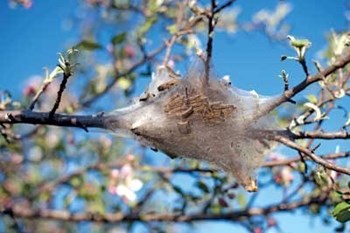
With spring comes a much-awaited opportunity for the beautification of condo green spaces, many of which may have been neglected throughout the colder months. Yet the arrival of warm weather also heralds the arrival of pesky insects and other plant pests that may impede a manager’s landscaping plans.
Fortunately for condo management, experts say many native New England plant pests are easily controlled. “A lot of times you’ll find that pests that are native to a geographic area never, or very rarely, cause significant problems,” says arborist Don Parrott, a board member of the Connecticut Tree Protective Association, “because if it evolved in a certain area, plants that are there also evolved with different checks and balances which keep that pest under control.”
Coccoidea
Among native pests that do require a manager’s attention, New England’s wide variety of scale insects (Coccoidea) are perhaps the most common offenders. The parasitic pests quickly attach themselves to plant leaves, secreting a waxy, scale-like coating that makes them resistant to many pesticides.
These immobilized insects draw nourishment from sap flowing throughout the plant’s vascular system, causing eventual death to the host. Despite resistance to many common pesticides, scales can often be treated with simplehorticultural oils or insecticidal soap.
Leaf Miners
Leaf miners, such as New England’s native birch leafminer (Fenusa pusilla), will first be seen throughout the region’s trees in May, their appearance followingquickly on the heels of developing foliage.
Easily recognized by the distinctive, curving paths they create on the leaves of their hosts, first generation leaf miner infestations can cause complete defoliation of a property’s trees in less than a season. From there, subsequent generations will often lead to weakeningand death of the host plant. If found early, leaf miners are controllable with organic insecticides sprayed directly on the leaves of an affected tree.
Bronze Birch Borer
Another native pest, the bronze birchborer (Agrilus anxius) is a common wood-boring beetle found throughout much of North America and is particularly prevalent in the Northeast. Though the borer can prove deadly to any birch tree on a condo property, New England’s white-barked Canoe Birches are most susceptible.
While the BBB is treatable with insecticides – sometimes requiring as many as three treatments a year – property managers should take care to plant only native white birch trees whenlandscaping plans call for these white-barked beauties. The often-seen Asian and European variants, frequently sold in American nurseries, show even less resistance to the borer’s attack.
Aphids
Aphids (Aphididae), another native New England parasite, feed on small plants and shrubs in much the same way as scale insects, and, in addition to their parasitic feeding habits, these small, pear-shaped pests often carry deadly plant viruses. In fact, one recentstudy shows aphids to be responsible for approximately 50% of all plant virus transmissions.
Noticeable effects of an aphid infestation on a property’s plants and shrubs may range from yellow, brown, or curling leaves to wilting and death. Upon discovery, these dual-threat insects should receive rapid attention. Fortunately for condo managers, most aphids are readily controllable with traditional chemical treatments, and some even respond to “greener” methodssuch as biological insecticides or the introduction of predator insects.
Eastern Tent Caterpillar
Another common New England pest, the eastern tent caterpillar (Malacosoma americanum) is most recognized by the white, billowy masses it creates in the crooks of apple and other fruit trees. ETC infestations are often easily remedied, though the insects rarely cause serious damage to a property’s trees. Should management choose to take action, condo groundskeepers can usually clip the larval egg sacs and the caterpillar’s cottony tents from fruit trees and other ornamentals, then simply burn the offending branches.
Condominium managers should take care not to confuse the eastern tent caterpillar with the similar-looking but far more destructive gypsy moth caterpillar, which, Parrott says, despite common misconception is not a New England native. “Most of us think of it as a native New England pest,” he explains. “But actually they’re not native pests, they’re a pest that was introduced. I think some scientist was trying to make silk or something and so he imported these caterpillars from Asia, had them in his laboratory busily making silk, and they escaped into our environment and became a pest.”
Hemlock Wooly Adelgid
But gypsy moths are hardly the only Asian visitors to plague New England properties in recent decades. “In Connecticut,” notes Parrott, “one of the big pests is hemlock wooly adelgid (Adelges tsugae). It’s a relatively new insect…and it’s just totally wiping out all of the native hemlock trees.”
A particularly pervasive pest, the HWA has spread throughout New England since its introduction from Asia and has, in fact, blanketed much of the East Coast. Yet the insect has proven particularly destructive in New England, where the ubiquitous hemlock has long been such a familiar fixture. “It’s a very tiny sucking insect – sucks sap from the twigs of the trees. And it may take ten years or so, but once the infestation develops on a tree, in about ten years it will kill them,” says Parrott. “But in a residential setting – you know, a managed property like a condominium property – with the righttreatment you can keep them alive.”
Asian Longhorned Beetle
Another Asian émigré, the Asian longhorned beetle (Anoplophora glabripennis) was first discovered in the New York area in the mid-1990s, and has since begun spreading throughout New England, proving one of the most destructive insects to plague the region in modern memory. Easily recognized by its black-and-white-banded antennae and blue leg colorings – “a very striking beetle,” notes Rhonda Santos of the USDA’s Animal Plant Health Inspection service – the ALB has become the target of serious government action in recent years. “A cross-section of an ALB-infested tree is going to look like Swiss cheese because of the tunneling galleries from the larvae feeding within,” Santos explains. “Treesthat it attacks are essentially being eaten from the inside out, so it’s kind of sad if you’re a tree lover.”
And saddest of all for property managers, some of whom may have spent decades cultivating stands of ornamentals, the discovery of Asian longhorned beetles at a condo is frequently an automatic death sentence for a property’s trees. “The federal government is trying to manage the onslaught of the insect. So it’s really taking it almost like an armed battle,” says Parrott. “If they find it, they just move in. When the feds get in there, they will just quarantine a certain area – dictate that it might be a half mile radius, for instance. They’ll go in with government contracts, cut every tree [and] grind it up so that any insects inside that wood are completely destroyed. By doing it that way, they’retrying to manage the spread of it.”
Emerald Ash Borer
Yet despite the growing media attention focused on ALB, surprisingly, another Asian pest has proven far more destructive. “Emerald ash borer (Agrilus planipennis or Agrilus marcopoli) is not at all on the same scale. It’s like a thousand-fold worse,” Parrott remarks. “One of the big problems with it is that it moves very easily on its own. The Asian long-horned beetle is what we’d consider, from an insect perspective, a very poor flyer…. The emerald ash borer, on the other hand, is a very good flyer.
“The feds [seem to] have decided it’s impossible to really very effectively contain it.” And while the slow-moving ALB has progressed through only a few New England states during its 15-year U.S. visit, the emerald ash borer has spread throughout fourteen states and parts of Canada in less than a decade. “I think they’re giving up ontrying to contain it,” Parrott notes. Unlike the Asian long-horned beetle, however, EAB attacks can be treated without sacrificing a property’s entire tree population. “If it gets into an area, if we have individual specimen trees, we can treat them and keep them alive,” says Parrott. “But that would be individual specimens, you know, like on a residential property.”
When insect problems do arise, university extension offices can frequently provide answers to a board member’s questions. “A lot of times folks might send a picture in and say ‘I’ve got this tree’ or ‘I’ve got these spots on these leaves,’” explains Donna Ellis, senior extension educator for the University of Connecticut’s Plant Science Department. “There are [extension] offices where master gardeners work. There are faculty members and staff members and people like myself who could help identify something and then make recommendations.”
In addition, “most states would have arborist associations,” says Parrott, “so [property managers and condo boards] could consult with their state arborist association and that should be able to point you to some qualified capable arborists. Similarly, they should have statewide nursery contractor associations. Your property managers will get some overlap.”
Experts like Parrott are careful to caution that managing a property’s insect pests is a year-round activity. It begins in spring, but does not end with the onset of cold weather. “In the winter,” Parrott notes, “property managers need to be dialed in more to review what happened last year, what got away from us, and what were some of the issues that we seemed to be behind the eight ball on.” And when a new pest problem does arrive, it will likely be a part of board members’ lives for years to come. “You have to treat it ongoing. It may take a treatment, just one application or something, every three years. But you must keep that up, whatever your issue is,” says Parrott. “It may not be that you need to spend money or do something everyyear, but you need have a program in place that is followed and you can usually keep the trees that you want.”
Exercise Restraint
Most importantly, says Ellis, managers should exercise restraint in pest control, perhaps saving themselves dollars and headaches in the process. “I think I would just welcome and encourage condominium owners and those who are maintaining the grounds to... take things in stride and realize that a plant, to be healthy, doesn’t have to be 100% free of holes or spots. It’s good that we do have some tolerance. Sometimes it’sokay for plants to have some damage if they’ve got beneficial insects or caterpillars or beautiful butterflies,” says Ellis.
“I think it’s good for us to exercise some tolerance and accept the fact that plants can have some degree of damage to them and they’ll still be fine.”
Matthew Worley is a freelance writer and a frequent contributor to New England Condominium magazine.






Leave a Comment